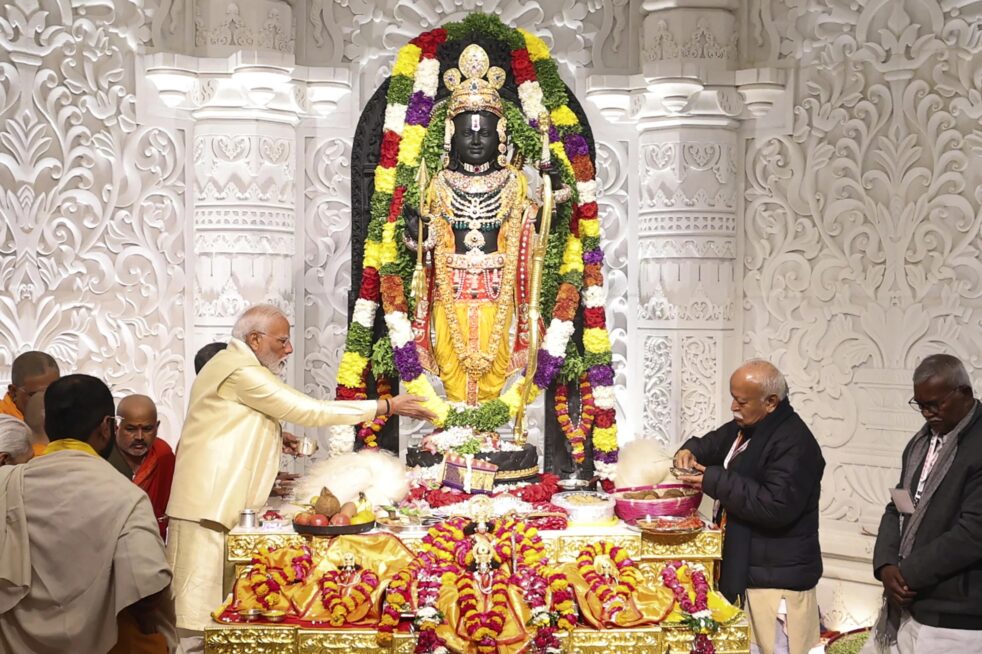On Jan. 22, about 80 chartered and private jets carrying prominent Indian public figures, including industrialist Mukesh Ambani and actor Amitabh Bachcan, landed in Ayodhya — an Indian city whose per capita income was less than $700 in 2021-22. Such was the influx of jets at the international airport, which the city inaugurated in December last year, that there was no space to park them.
“The planes will depart after dropping guests,” said airport manager Saurabh Singh. These passengers, along with thousands of other VIP guests, had flocked to Ayodhya to witness the consecration of a grand Hindu temple of Lord Ram at the site where a mosque once stood 35 years ago.
The 70-acre, three-story, pink sandstone temple marked a moment of jubilation for the ruling political party, Bharatiya Janata Party (BJP), and other Hindu nationalist groups. They consider it to be the manifestation of their vision to revive the Hindu pride suppressed during Mughal and British rule in India.
The temple is estimated to cost $217 million and is funded entirely by donations. In 2014, the BJP came into power under Prime Minister Narendra Modi, who faces accusations of promoting Hindu supremacy and converting secular India into a Hindu nation. Speaking at the event, Modi called Jan. 22 the “beginning of the new time cycle.”
“Ram is not a dispute. Ram is the solution. By moving ahead of building the temple, now we all take the oath of building an India that is capable, successful, beautiful and divine,” he said.
The event was grandly covered worldwide as Indian missions live telecasted the event to raise awareness. Times Square displayed images of the idol and temples, and the Indian diaspora in different countries took out solidarity marches and waved saffron flags, a color associated with the Hindu political movement.
The temple invokes a profound sense of pride and fulfillment within Akshat Karwa, third-year CS, who grew up around 140 miles from Ayodhya. “This moment, anticipated by our forebears for centuries, is a privilege for our generation to partake in,” he added.
Despite the temple’s scheduled completion by the end of this year, the BJP hurried its inauguration to appeal to Hindu voters ahead of national elections in May. Some political analysts even dubbed the inauguration as the implicit launch of the party’s election campaign. Modi and BJP are eyeing a record third stint in power. Instead of priests, Modi led the inauguration ceremony, who had partaken in 11 days of special rituals. Therefore, many opposition parties denied the invitation and asserted the event had been politicized. It is a “completely political Narendra Modi function,” said Indian politician Rahul Gandhi.
Ayodhya holds a prominent religious significance in Hinduism. It is believed to be the birthplace of Hindu pantheon Lord Ram, who is worshipped and emulated by millions of Hindus. Indian festivals such as Diwali and Dussehra are also associated with the mythological tales of Ram. In the years preceding the inauguration, Ayodha has seen a $3.85 billion makeover. Now, it houses a brand-new airport, an expanded railway station and several luxury hotel chains.
“The Ram Janmabhoomi Teerth Kshetra [shrine] in Ayodhya would be developed on the lines of the Vatican City and the Mecca,” said Rabindra Narain Singh, president of Vishwa Hindu Parishad (VHP), a right wing Hindu nationalist group.
However, the events leading up to the inauguration have not been peaceful. In 1528, a temple allegedly stood at the same spot. Mughal ruler Babur destroyed the temple and constructed the Babri Masjid (Mosque). The 2.77 acres of that land has been disputed ever since. The dispute adopted a national nature in the 1980s when the BJP and the VHP took up the issue and vowed to build a temple at the same location. Since then, the BJP has been using Hindutva rhetoric to appease the Indian Hindus. Hindutva refers to the political ideology that justifies Hindu nationalism and converting India into a Hindu state. The movement culminated in 1992 when Hindu zealots tore down the Babri Masjid, inciting riots that killed thousands and forever changed the political landscape of India. The aftermath resulted in an exponential rise of the BJP into current dominance as well as religious riots that caused more than 2000 deaths. In 2019, the Supreme Court of India ruled that the entire 2.77 acres of land belonged to the Hindu litigants, ending the legal dispute over the land.
An alternate land was allocated to the Muslim petitioners to rebuild the Mosque in addition to the creation of an Indo-Islamic Cultural Foundation, which is spearheading the construction of the new Mosque and was created as an order of the Supreme Court during the Babri Masjid title dispute case.
“The construction of the temple is going on as per the direction of the Supreme Court, so we welcome it. I don’t think there’s any feeling of ill-will in the Muslim community,” said Zufar Ahmad Faruqi, head of the Indo-Islamic Cultural Foundation.
However, the sentiment is not shared by all Indians, both in the country or globally. Hassan Ali, who was present during the 1992 riots, was just nine years old when he had to escape to a police station to save himself.
“In 1992, there were many stories of local Hindus and Muslims helping each other. However now, there is a lot more poison that has been fed to people, so one cannot tell anymore. One cannot tell what people have in their hearts,” Ali said.
Although Hindus are celebrating the temple worldwide, it follows multiple incidents of religious fanaticism and violence on the streets and the internet over decades. As the Hindu groups, backed by the ruling dispensation, demand the razing of more mosques in the cities of Varanasi and Mathura, more citizens question the secular nature of the Indian state.
